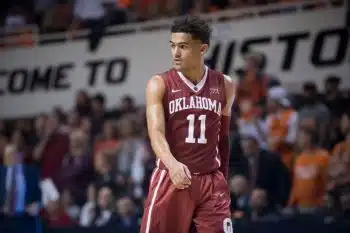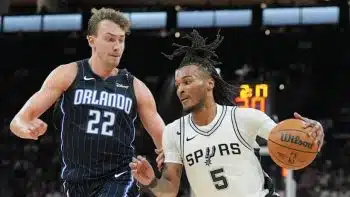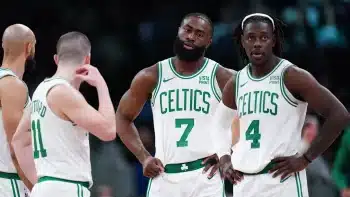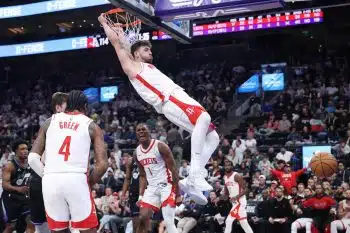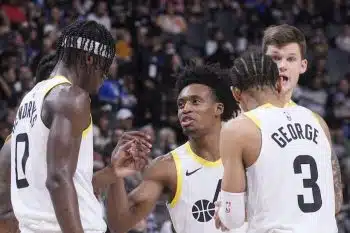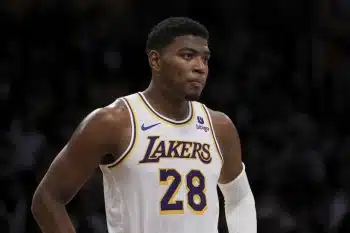NBA
Gilgeous-Alexander’s Superb Start Pushes A Lofty Ceiling Even Higher
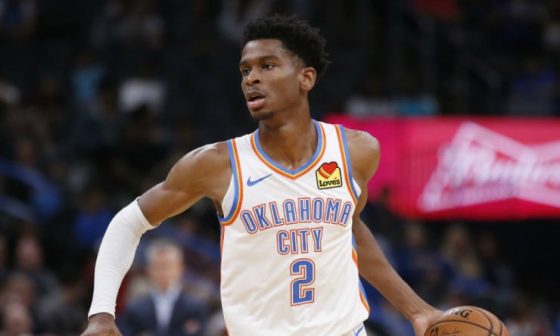
The Los Angeles Clippers never wanted to trade Shai Gilgeous-Alexander.
As Kawhi Leonard waited to sign his contract to ensure his new team had a deal in place for Paul George, the Clippers had already agreed to send a record-setting collection of first-round picks – four of which include no protection whatsoever – to the Oklahoma City Thunder. According to The Athletic’s Jovan Buha and Sam Amick, LA’s hopes of forming perhaps basketball’s best wing tandem since Michael Jordan and Scottie Pippen hinged on its inclusion of Gilgeous-Alexander in the prospective package for George.
Based on reputation and numbers alone, the decision should have been easy. Gilgeous-Alexander wasn’t a blue-chip prospect going into his freshman season at Kentucky or even his debut campaign in the NBA after he vaulted up draft boards to the lottery. His rookie season was extremely encouraging, but there was reasonable debate as to just how high Gilgeous-Alexander’s star could rise.
George, meanwhile, was coming off the best season of a career that’s tracking toward the Hall of Fame. He finished third in MVP voting and was in the thick of his prime at 28. More importantly, Leonard putting pen to paper hinged on the Clippers’ acquisition of George.
Was a sophomore combo guard that averaged barely more than 10 points per game his rookie season worth sacrificing years of imminent title contention? There’s no detailed reporting on the extent of LA’s hesitance to part ways with Gilgeous-Alexander, but the notion that any doubt existed whatsoever speaks to just how highly head coach Doc Rivers and company thought of him.
Given Gilgeous-Alexander’s performance during his first few games with the Thunder, too, that lends stunning credence to the Clippers’ reluctance.
Coming into 2019-20, the question wasn’t whether he’d be a positive two-way player during his first season in Oklahoma City. Gilgeous-Alexander was rock solid last year, even showing flashes of brilliance on a nightly basis, culminating in a spot on the All-Rookie Second Team. He was even more impressive during the Clippers’ hard-fought six-game loss to the Golden State Warriors in the first round of the playoffs, introducing himself to a national audience by scoring at least 22 points twice and, at times, effectively guarding each of the opposing stars.
Even considering an updated appraisal of his career trajectory after the playoffs, Gilgeous-Alexander blew away optimistic expectations over the first week of the regular season. He’s averaging 21.6 points, 7.1 rebounds and 3.2 assists per game on slightly above average efficiency. He leads his veteran team in points, usage and shot attempts, while, maybe most telling of Gilgeous-Alexander’s impact, the Thunder’s offensive rating when he’s on the bench is a putrid 75.0, per NBA.com – by far the worst on the roster.
The sample size is small, obviously, and there’s always noise involved in early-season on-off numbers, especially for a thin team like Oklahoma City. But the eye test serves as a ringing endorsement of both Gilgeous-Alexander’s gaudy statistical output and his overall influence on the Thunder, even when he fails to finish.
The possession above illustrates what separates Gilgeous-Alexander from the vast majority of young guards with nascent star potential: pace. He’s never rattled by pressure with the ball in his hands, routinely uses hesitation dribbles to keep his defender off balance and has already mastered the art of keeping the defense on his back in pick-and-roll play, putting defenders in “jail.” Such a high-level understanding of timing and angles as a ball-handler takes years for most playmakers to develop; Gilgeous-Alexander has it at 21.
He’s averaging 16.8 drives per game, ninth-most in the league, and taking 9.5 shots per game on those herky-jerky forays to the rim. Only Kyrie Irving and Trae Young average more shots while penetrating than Gilgeous-Alexander, but neither are shooting better than his 52.6 percent — a number he’s bound to improve upon once getting more comfortable with his off-hand.
But for now, Gilgeous-Alexander’s nuance as a ball-handler combined with his long arms, long strides and quick first step has made it nearly impossible to keep him out of the paint. And once there, he’s been able to mitigate the effect of trailing contests or help shot-blockers with an array of finishes, most commonly a one-handed scoop layup that’s quickly becoming a signature.
Gilgeous-Alexander had one of the lowest three-point rates in the NBA among starting guards last season. The only backcourt stalwarts who took fewer threes per field goal attempt than him were Ben Simmons, DeMar DeRozan and Kris Dunn, according to data compiled at Basketball Reference. That company of non-shooters, fortunately, isn’t an accurate portrayal of Gilgeous-Alexander’s shooting ability from deep, a reality laid bare in the playoffs, when he connected on half of his 18 triples.
But it’s not like Gilgeous-Alexander hinted at a future of alpha-dog shot-making against Golden State, either. Through four games with the Thunder, though, he looks every bit the part of a dangerous shooter from all over the floor, whether off the catch or the dribble. Gilgeous-Alexander is launching 5.5 threes per game so far and hitting them at 36.4 percent, a respectable clip that’s deflated by a majority of his attempts coming off the bounce.
Gilgeous-Alexander’s release is relatively slow and begins from below his waist. Unless he completely reworks his shooting motion, he won’t ever be the type of player sprinting off screens, needing just the smallest sliver of room between him and the defense before letting fly. But Gilgeous-Alexander is too talented with the ball to play that more finite role anyway, and the imminent threat of his drive is already forcing defenders to give him enough breathing room to shoot threes cleanly.
Most encouraging might be the confidence and frequency with which he’s taking tries from deep. Gilgeous-Alexander isn’t hesitating to shoot early in the shot clock nor from above the break and has occasionally hunted three-pointers when he finds himself guarded by a bigger defender on switches.
The ease and comfort with which Gilgeous-Alexander plays has made it increasingly difficult to remember just how meteoric the rise has been. He wasn’t even a top-25 recruit as a high school senior, nor a full-time starter for John Calipari until January of his freshman season. He was a role player, in every sense of the word, as a rookie with clear holes in his game offensively.
Now, Gilgeous-Alexander is a three-level scorer with the defensive chops to guard multiple positions. That lineup scalability extends to the offense, too, where he was initially projected as a pure point guard but is currently making his biggest impact as a primary scorer — sprinkling dashes of plus passing ability and innate court sense in between.
It’s unclear where exactly Gilgeous-Alexander’s game will go from here. His rapid growth over the past two years not only makes it foolish to put a cap on his ceiling but continues raising his floor higher and higher.
The Thunder have always been identified most by the singular play of their superstars. Yet only four months after finally hitting reset on a team that had been chasing titles for the better part of a decade, it seems more possible than ever that Oklahoma City might already have its next one.
